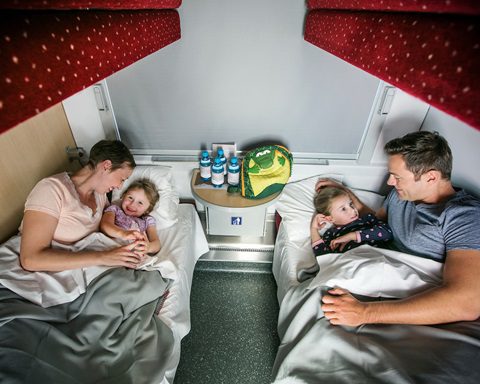 There is a reason night trains are making a resurgence in Europe. Not only are they a convenient and efficient way to travel across Europe, they are also comfortable and budget-friendly. Here, Rail Europe provides a guide on what travellers can expect for their overnight European train trips.
There is a reason night trains are making a resurgence in Europe. Not only are they a convenient and efficient way to travel across Europe, they are also comfortable and budget-friendly. Here, Rail Europe provides a guide on what travellers can expect for their overnight European train trips.
Speed of night trains vs day trains
While night trains may not match the speed of certain daytime high-speed services, they are certainly faster than most regional services and are a good way to go from one city to another while being lulled to sleep.
Cost effectiveness
Night trains are considered cost effective as they are essentially a 2-in-1 deal as both your travel and accommodation are covered in the ticket price. However, note that fares vary greatly from route to route – some fares on the same train may cost as little as €29, while others could go up to €600. This is because the fares reflect the type of seat or sleeper booked. The cheapest tickets are generally assigned to the seating carriage, while the more expensive options are for the sleeping carriages, where you’ll find couchettes and premium sleeper compartments.
Comfort levels
The level of comfort depends on the option chosen – seat, couchette or sleeper. The most basic option is the seating carriage, where the seats recline, but they are not flat beds.
For the comfort of flat bed, more space, increased privacy and better amenities, the couchette or sleeper make better options. The more affordable of these two options is the couchette, which is a four or six-person compartment that comes with fresh bed linen, towels and a shared toilet.
Sleepers, on the other hand, are the most expensive option as they come with the most privacy and amenities. Designed for one to four passengers, sleepers often feature a private ensuite, bed-making services, along with fresh linen and towels. Depending on the route and season, it can be significantly more expensive than other tickets. Always compare routes and providers for the most suitable service.
Sustainability
Cars and planes contribute to 85% of the EU greenhouse gas emissions, while trains make up 0.4%. Travelling by night train is undoubtedly the greener option.
Scenic
Even though you’d be sleeping through the night, that doesn’t mean you won’t enjoy the before, during and after – i.e. spectacular sunsets, starry night skies, lit-up city nightscapes and the first light at dawn. These make up some of the more special moments when travelling on night trains in Europe.
Operators
There are four main operators offering night trains across Europe:
ÖBB Nightjet: Operated by Austria’s ÖBB, Nightjet offers routes between Austria, Germany, Italy, Switzerland, Poland, Hungary, Slovenia, Croatia, the Czech Republic and Belgium. Their most popular routes include Vienna to Zurich, Brussels to Vienna, Zurich to Hamburg and Vienna to Venice.
EuroNight: EuroNight is run by a network of rail operators that seamlessly coordinate overnight routes across Western, Central, and Eastern Europe. Some of their popular routes include Berlin to Budapest, Prague to Zurich, Munich to Zagreb and Zürich to Ljubljana.
Night trains in France: SNCF Intercités de Nuit runs domestic overnight routes to and from Paris connecting passengers between the City of Light and the Mediterranean or the Alps. Popular routes include Paris to Toulouse, Nice, Rodez and Briançon.
Night trains in Italy: Trenitalia Intercity Notte runs regular overnight services across the country connecting with Milan, Rome and Venice. Their most popular routes are Lecce to Milan, Palermo to Rome, Turin to Naples and Rome to Trieste.
















